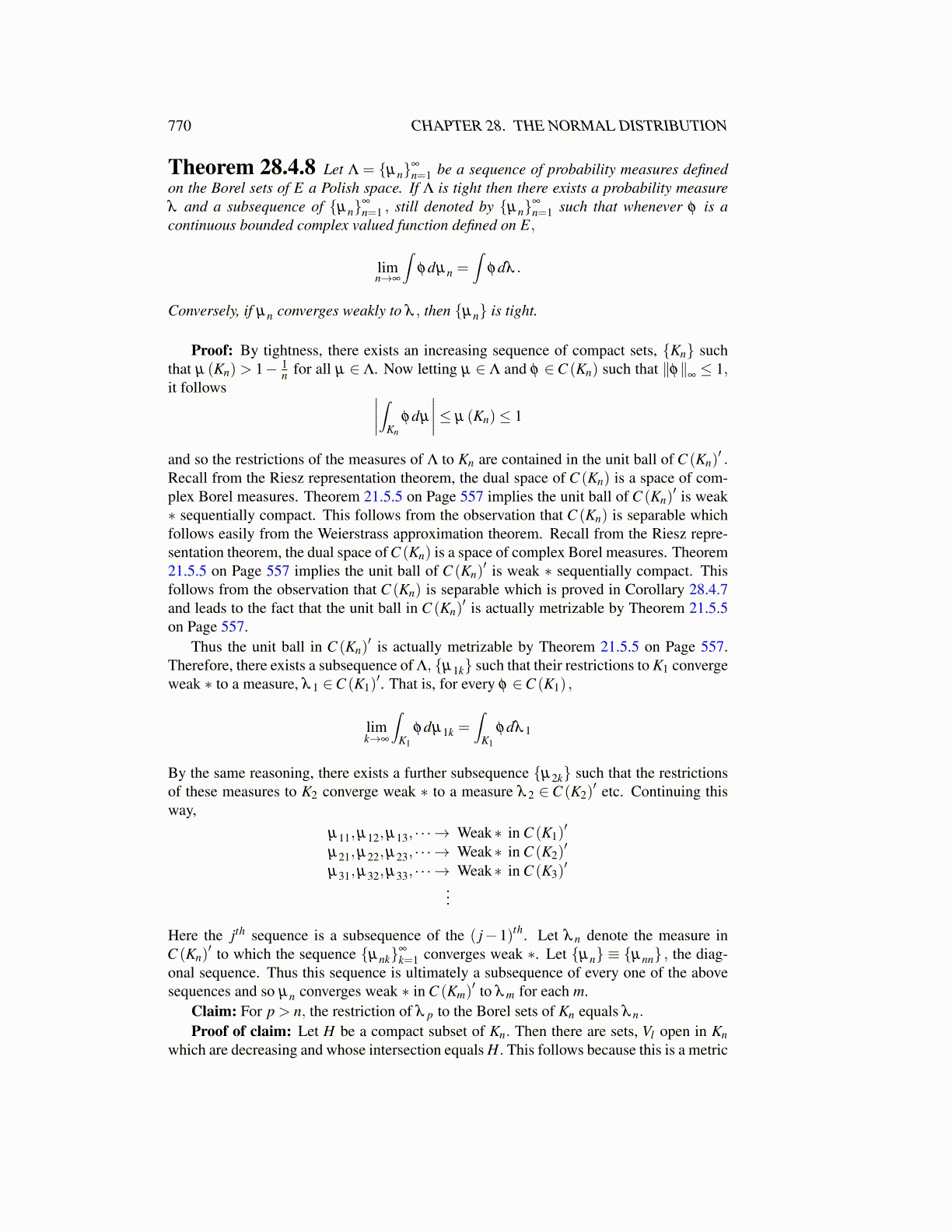
770 CHAPTER 28. THE NORMAL DISTRIBUTION
Theorem 28.4.8 Let Λ = {µn}∞
n=1 be a sequence of probability measures definedon the Borel sets of E a Polish space. If Λ is tight then there exists a probability measureλ and a subsequence of {µn}
∞
n=1 , still denoted by {µn}∞
n=1 such that whenever φ is acontinuous bounded complex valued function defined on E,
limn→∞
∫φdµn =
∫φdλ .
Conversely, if µn converges weakly to λ , then {µn} is tight.
Proof: By tightness, there exists an increasing sequence of compact sets, {Kn} suchthat µ (Kn)> 1− 1
n for all µ ∈ Λ. Now letting µ ∈ Λ and φ ∈C (Kn) such that ∥φ∥∞≤ 1,
it follows ∣∣∣∣∫Kn
φdµ
∣∣∣∣≤ µ (Kn)≤ 1
and so the restrictions of the measures of Λ to Kn are contained in the unit ball of C (Kn)′ .
Recall from the Riesz representation theorem, the dual space of C (Kn) is a space of com-plex Borel measures. Theorem 21.5.5 on Page 557 implies the unit ball of C (Kn)
′ is weak∗ sequentially compact. This follows from the observation that C (Kn) is separable whichfollows easily from the Weierstrass approximation theorem. Recall from the Riesz repre-sentation theorem, the dual space of C (Kn) is a space of complex Borel measures. Theorem21.5.5 on Page 557 implies the unit ball of C (Kn)
′ is weak ∗ sequentially compact. Thisfollows from the observation that C (Kn) is separable which is proved in Corollary 28.4.7and leads to the fact that the unit ball in C (Kn)
′ is actually metrizable by Theorem 21.5.5on Page 557.
Thus the unit ball in C (Kn)′ is actually metrizable by Theorem 21.5.5 on Page 557.
Therefore, there exists a subsequence of Λ, {µ1k} such that their restrictions to K1 convergeweak ∗ to a measure, λ 1 ∈C (K1)
′. That is, for every φ ∈C (K1) ,
limk→∞
∫K1
φdµ1k =∫
K1
φdλ 1
By the same reasoning, there exists a further subsequence {µ2k} such that the restrictionsof these measures to K2 converge weak ∗ to a measure λ 2 ∈ C (K2)
′ etc. Continuing thisway,
µ11,µ12,µ13, · · · → Weak∗ in C (K1)′
µ21,µ22,µ23, · · · → Weak∗ in C (K2)′
µ31,µ32,µ33, · · · → Weak∗ in C (K3)′
...
Here the jth sequence is a subsequence of the ( j−1)th. Let λ n denote the measure inC (Kn)
′ to which the sequence {µnk}∞
k=1 converges weak ∗. Let {µn} ≡ {µnn} , the diag-onal sequence. Thus this sequence is ultimately a subsequence of every one of the abovesequences and so µn converges weak ∗ in C (Km)
′ to λ m for each m.Claim: For p > n, the restriction of λ p to the Borel sets of Kn equals λ n.
Proof of claim: Let H be a compact subset of Kn. Then there are sets, Vl open in Knwhich are decreasing and whose intersection equals H. This follows because this is a metric